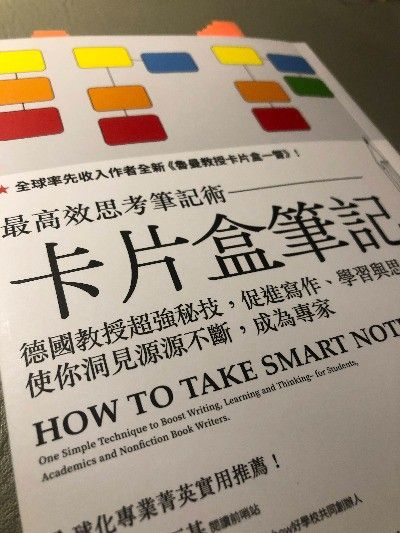Reading Experience #6 - "Card Box Notes" | Efficient thinking and note-taking for writing
Title: How to Take Smart Notes
Author: Sonke Ahrens
Publication date: 2022/04/27

About the Author
German scholar, now teaching philosophy of education at the University of Duisburg-Essen, Germany. He taught at the Bundeswehr University in Munich. In addition to this book, he is the author of Experiment und Exploration: Bildung als experimentelle Form der Welterschließung (Experiment und Exploration: Bildung als experimentelle Form der Welterschließung), which is included in the "Contemporary Philosophical Theory of Education" series.
Card Box Notes
1. Fleeting notes
Carry a note-taking tool with you and jot down any ideas that come up. Don't worry about how or what to write on it, because it's just a temporary note. It's like the "inbox" mentioned in the book "Get It" earlier.
2. Literature notes
Or called reading notes, you can interpret and record what you read in your own words and what you think may be used in the future. Put these notes in the same place as your bibliographic material, these are your reference system.
3. Permanent notes
This is the card box part, where we develop ideas into insights, arguments, arguments by going through the first two notes once a day. To write our ideas into a form that can be published to others, that is, to write complete sentences and paragraphs, and the content should be as accurate, clear, and concise as possible.
The permanent notes are then placed in a card case, along with related notes, to develop a common theme. Challenge and reinforce your own arguments through constant reading and note-taking, and change or develop your personal argument based on new learnings.
Four basic principles
Principle 1: Writing down is the only thing that matters
Writing begins when taking notes. When we focus on writing, it not only makes us more impressed, but also makes us more focused on related fields. Output is the best way to learn.
Principle 2: Simplicity is the most important
When ordinary people take notes, they often draw a line when they read an interesting sentence, write in the blank space next to what they think, and write what they think of in the notebook. Slowly, there will be a lot of different notes on hand, scattered everywhere, becoming very complicated and difficult to organize.
During the note-taking process, the question you will encounter is: under which topic do I place this note? But after we've used the card box note-taking method, you have new questions: in which context do I want to see it again?
The difference is that in the past, when we wrote notes, we classified them under one topic, and we might not move them after we wrote them down. But when making card box notes, we will link this note with other related notes to form a context, so that we can see this note again under the same topic in the future.
Principle 3: No one starts from scratch
Writing is not when you set a topic today and start writing what you want to write. Instead, he usually keeps making notes on related topics, and eventually turns the accumulated content into articles.
As long as you focus on the areas you are interested in, and keep recording the process of your brain thinking, the themes, questions, and discussions will naturally emerge from the material without effort. We also don't have to worry about running into uninspired situations.
Principle 4: Let work lead you forward
A good work process can be turned into a positive cycle. If we can have a growth mindset and are willing to change in order to do better, the work system will take you to continuous improvement.
How to write using the card box note-taking method?
Step 1: Focus on each work item, don't "multitask"
As I mentioned in the reading experience of "Get It", human beings cannot achieve "multitasking", which will greatly reduce their productivity. The so-called "multitasking" is not focusing on several things at the same time. Rather, we quickly divert our attention between two (or more) things.
With the card box note aid, we record our work items on different notes, allowing us to free our brains to focus on one thing.
Step 2: Read for Comprehension
If you can't say it clearly, you can't really understand. To understand something, we don’t have to read it constantly, we have to actually think about it and use our own words to interpret it. Repeated reading of content is not only meaningless, it is useless for comprehension or learning.
Step 3: Take Notes Every Day
"Forgetting" promotes long-term learning. We write down notes every day, in addition to emptying the things in our heads, it is much easier to accumulate notes one by one than to write a whole long article in one breath.
Step 4: Develop the idea
By linking between different notes, we can occasionally extract previous ideas and facts and link them with other information, which is actually the way experts recommend to everyone.
The ability to generate innovative ideas has more to do with breaking old thinking patterns, rather than generating as many ideas as possible. The author mentioned in the book that we can use the card box as a tool to help us break our original thinking habits.
Step 5: Share Insights
Only those who "think that writing is a separate task, separate from the rest of life" will bother to write without a title. For those of you who have card boxes, we just look at our card boxes and if we've had a good idea before (more likely we've had a good idea in the last few months, instead of idea that popped up in a few minutes), that topic is there.
Step 6: Form a Habit
Changing behavior is not about breaking old habits or forcing yourself with willpower, but strategically building new habits to replace old ones.
Creativity just connects things. When we ask creative people how they do it, they get embarrassed because they don't really do anything, they just see something.
— Steve Jobs

after reading
The card box note-taking method is a method that teaches you from taking notes to writing, and its focus is on "connection". In the past, we used to take notes independently, and it was often forgotten after a few days after taking notes. However, because the card box notes are linked to form a context, notes on the same topic will be linked together. Taking notes regularly will not only help you master knowledge, but also help with writing. We need to know that writing begins when you take notes, not when you see the title and start thinking about the content.
This book has changed my thinking about note-taking and writing. The change I want to make is to gradually change the content of notes from key excerpts to my own interpretation ideas. I am currently focusing on learning the 3-level tool (Evernote). In the future, I will want to actually use the card box note-taking method. The tools include Obsidian, Roamresearch, Logseq, Heptabase, etc.
I recommend this book to anyone who finds study hard, and to anyone who wants to write but has no inspiration.
If you are interested in card box notes and want to see a more detailed explanation, you can buy "Card Box Notes"
This article was published simultaneously on Vocus and Medium .
Welcome to follow me, support me with clap, and share your thoughts in the comments section!
Like my work? Don't forget to support and clap, let me know that you are with me on the road of creation. Keep this enthusiasm together!
